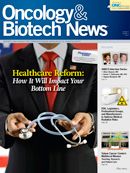Clarient Launches Pulmotype to Help Oncologists Choose the Right Therapy
In early February, Clarient Inc announced the commercial launch of its Insight Dx Pulmotype test that helps pathologists classify specific types of lung cancer so physicians can prescribe the most effective therapies.
Click here to view as PDF.
In early February, Clarient Inc announced the commercial launch of its Insight Dx Pulmotype test that helps pathologists classify specific types of lung cancer so physicians can prescribe the most effective therapies. Kenneth Bloom, MD, chief medical officer for Clarient, says Pulmotype— a 5-antibody immunohistochemistry test—can make a huge difference in how physicians treat patients with non—small cell lung cancer (NSCLC).
Bloom said, “One of the big advances that has occurred in lung cancer over the last 6 years or so is that some of the drugs that are now utilized in the treatment of the disease, like Avastin [bevacizumab] and Alimta [pemetrexed], have some histology decision points around them.” In the past, Bloom explained, pathologists often reported their lung cancer biopsy results simply as NSCLC, providing oncologists with little direction as to what treatment to prescribe. Bloom said it is an educational priority to make sure pathologists know that limited diagnosis is not good enough in 2010. “Instead of just calling something an NSCLC, now it’s fairly important for pathologists to say whether it’s squamous histology or nonsquamous histology,” he said.
In creating Pulmotype, said Bloom, select transcripts identified during the human genome project were combined with ingenuity to create a robust, reproducible panel of antibodies that any pathologist can use to determine whether core biopsies are squamous or nonsquamous histology. This information enables the clinician to decide between Avastin or Alimta, which are indicated for different histologies, and provide patients with the therapy most likely to be effective.
“This isn’t actually personalized,” Bloom pointed out. “This is the first of what I call classifying disease more appropriately.” Now that the methodology is laid out, Bloom said, you can define other questions and if you have the appropriate cohorts to plug into the methodology, “you can build the answers to the question.”
Helping to classify disease is one of the tasks of a pathologist, Bloom said, noting that in lymphomas, classification defines the therapy choices. “It’s sort of stereotyping,” said Bloom. “It’s a way that we can create sort of broad trends, broad observations that we’re seeing. And we’re hoping that those broad observations translate to true molecular abnormalities that we can target in the future.”
To boost Clarient’s efforts in developing better biomarker tests, the firm acquired Applied Genomics Inc in December 2009. Bloom said the Applied Genomics acquisition enabled Clarient to narrow an important gap in the process of translating diagnostic findings to therapy selection. “We were going from diagnosis to really advanced molecular tools without really understanding what we were looking at,” he explained. The development engine created at Applied Genomics “provides a very important transition step of merging the molecular basis to morphology, putting the pathologist in the middle and then, hopefully, driving us back down to the detailed molecular underpinnings to really predict response to therapy in the future.” Clarient hopes it will lead to new diagnostic and prognostic cancer tests.
Bloom said it is an exciting time for Clarient—and an equally exciting time for pathologists. He said a gap has been growing between pathologists’ ability to diagnose cancer and oncologists’ desire to offer more personalized therapy for their patients. The commercial launch of Pulmotype brings the two a little closer.
“There’s a variety now of personalized approaches that you can start to look at for these nonsquamous lung cancers that can make the therapies that you apply very personalized,” Bloom said. “We’re narrowing the gap. And I think we’re providing a nice transition period for pathologists to be able to explain what the oncologists need to better treat their patients.”
